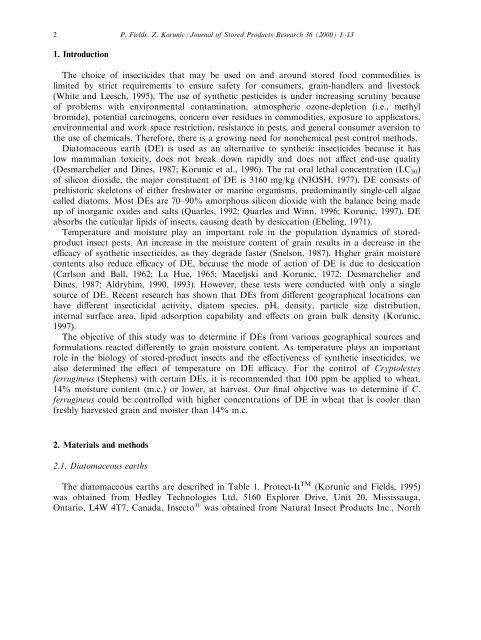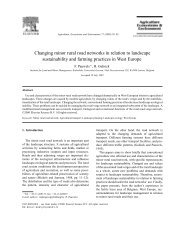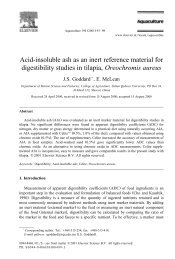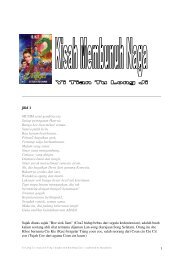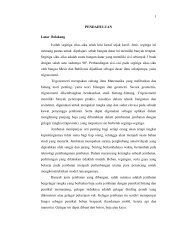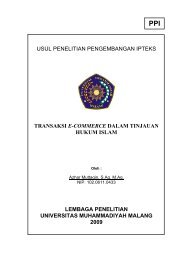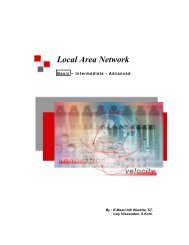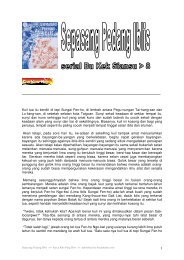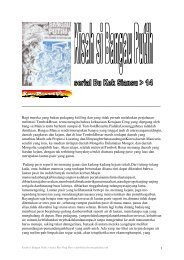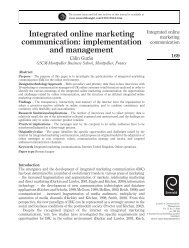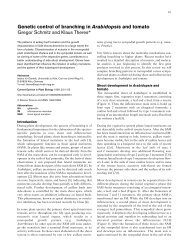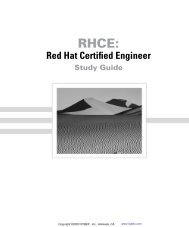The effect of grain moisture content and ... - Directory UMM
The effect of grain moisture content and ... - Directory UMM
The effect of grain moisture content and ... - Directory UMM
You also want an ePaper? Increase the reach of your titles
YUMPU automatically turns print PDFs into web optimized ePapers that Google loves.
2<br />
1. Introduction<br />
<strong>The</strong> choice <strong>of</strong> insecticides that may be used on <strong>and</strong> around stored food commodities is<br />
limited by strict requirements to ensure safety for consumers, <strong>grain</strong>-h<strong>and</strong>lers <strong>and</strong> livestock<br />
(White <strong>and</strong> Leesch, 1995). <strong>The</strong> use <strong>of</strong> synthetic pesticides is under increasing scrutiny because<br />
<strong>of</strong> problems with environmental contamination, atmospheric ozone-depletion (i.e., methyl<br />
bromide), potential carcinogens, concern over residues in commodities, exposure to applicators,<br />
environmental <strong>and</strong> work space restriction, resistance in pests, <strong>and</strong> general consumer aversion to<br />
the use <strong>of</strong> chemicals. <strong>The</strong>refore, there is a growing need for nonchemical pest control methods.<br />
Diatomaceous earth (DE) is used as an alternative to synthetic insecticides because it has<br />
low mammalian toxicity, does not break down rapidly <strong>and</strong> does not a€ect end-use quality<br />
(Desmarchelier <strong>and</strong> Dines, 1987; Korunic et al., 1996). <strong>The</strong> rat oral lethal concentration (LC50)<br />
<strong>of</strong> silicon dioxide, the major constituent <strong>of</strong> DE is 3160 mg/kg (NIOSH, 1977). DE consists <strong>of</strong><br />
prehistoric skeletons <strong>of</strong> either freshwater or marine organisms, predominantly single-cell algae<br />
called diatoms. Most DEs are 70±90% amorphous silicon dioxide with the balance being made<br />
up <strong>of</strong> inorganic oxides <strong>and</strong> salts (Quarles, 1992; Quarles <strong>and</strong> Winn, 1996; Korunic, 1997). DE<br />
absorbs the cuticular lipids <strong>of</strong> insects, causing death by desiccation (Ebeling, 1971).<br />
Temperature <strong>and</strong> <strong>moisture</strong> play an important role in the population dynamics <strong>of</strong> storedproduct<br />
insect pests. An increase in the <strong>moisture</strong> <strong>content</strong> <strong>of</strong> <strong>grain</strong> results in a decrease in the<br />
e cacy <strong>of</strong> synthetic insecticides, as they degrade faster (Snelson, 1987). Higher <strong>grain</strong> <strong>moisture</strong><br />
<strong>content</strong>s also reduce e cacy <strong>of</strong> DE, because the mode <strong>of</strong> action <strong>of</strong> DE is due to desiccation<br />
(Carlson <strong>and</strong> Ball, 1962; La Hue, 1965; Maceljski <strong>and</strong> Korunic, 1972; Desmarchelier <strong>and</strong><br />
Dines, 1987; Aldryhim, 1990, 1993). However, these tests were conducted with only a single<br />
source <strong>of</strong> DE. Recent research has shown that DEs from di€erent geographical locations can<br />
have di€erent insecticidal activity, diatom species, pH, density, particle size distribution,<br />
internal surface area, lipid adsorption capability <strong>and</strong> e€ects on <strong>grain</strong> bulk density (Korunic,<br />
1997).<br />
<strong>The</strong> objective <strong>of</strong> this study was to determine if DEs from various geographical sources <strong>and</strong><br />
formulations reacted di€erently to <strong>grain</strong> <strong>moisture</strong> <strong>content</strong>. As temperature plays an important<br />
role in the biology <strong>of</strong> stored-product insects <strong>and</strong> the e€ectiveness <strong>of</strong> synthetic insecticides, we<br />
also determined the e€ect <strong>of</strong> temperature on DE e cacy. For the control <strong>of</strong> Cryptolestes<br />
ferrugineus (Stephens) with certain DEs, it is recommended that 100 ppm be applied to wheat,<br />
14% <strong>moisture</strong> <strong>content</strong> (m.c.) or lower, at harvest. Our ®nal objective was to determine if C.<br />
ferrugineus could be controlled with higher concentrations <strong>of</strong> DE in wheat that is cooler than<br />
freshly harvested <strong>grain</strong> <strong>and</strong> moister than 14% m.c.<br />
2. Materials <strong>and</strong> methods<br />
2.1. Diatomaceous earths<br />
P. Fields, Z. Korunic / Journal <strong>of</strong> Stored Products Research 36 (2000) 1±13<br />
<strong>The</strong> diatomaceous earths are described in Table 1. Protect-It TM (Korunic <strong>and</strong> Fields, 1995)<br />
was obtained from Hedley Technologies Ltd, 5160 Explorer Drive, Unit 20, Mississauga,<br />
Ontario, L4W 4T7, Canada. Insecto 1 was obtained from Natural Insect Products Inc., North


